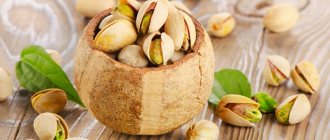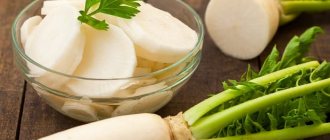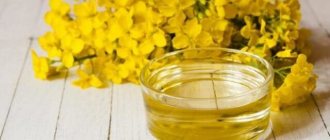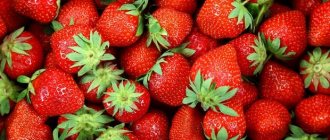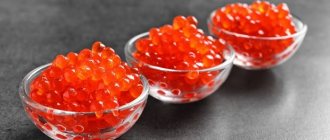Persimmon is a dietary product. The shape of the fruit is round, some varieties have the shape of a heart. The size of persimmon also depends on the variety and in some cases reaches 10 cm in diameter. The weight of the fruit ranges from 40 to 900 g. The average persimmon weighs 200-400 g. The peel is dense, the color can be different shades of orange, the thickness depends on the variety.
The energy value, that is, the ratio of BZHU (proteins, fats, carbohydrates), is 0.6/0.5/15.0. The calorie content per 100 g of persimmon is about 65 kcal; 1 medium-sized fruit contains about 250 kcal.
- Fasting day
Chemical composition
The composition of the product varies somewhat depending on the variety and usually includes minerals, vitamins, micro- and macroelements. Table of nutritional value and approximate amount of nutrients:
| Components | Approximate quantity per 100 g | |
| Microelements |
| |
| Vitamins |
| |
| Macronutrients |
| |
| Cellulose | Not less than 1.5 g | |
| Pectin | 0.47-1.04 g | |
| Sugar | From 25% to 35% of the total weight of the product | |
| Organic acids | Not less than 0.1 g | |
| Unsaturated fatty acids | From 0.1 to 0.2 g | |
| Saturated fatty acids | About 100 mcg | |
For children
Persimmon is gradually introduced into the diet of children in small pieces, starting from the age of three. The chocolate variety does not have a pronounced astringent effect, so it is recommended to start with it.
Although persimmons contain more useful vitamins than apples, if your child was born and is not growing up in a tropical or subtropical climate zone, then it is still better to give preference to the native apple tree. Find out about apples and their beneficial properties from our article.
For children over 10 years old who attend sports clubs and spend a lot of energy, persimmon will serve as a useful energy booster. It contains a lot of polysaccharides, which are easily absorbed by the body and converted into energy.
Varieties
There are about 170 varieties of persimmon.
The most popular are “wren”, “ox heart”, “apple” or “sharon” persimmon, “honey”, “chocolate”, “chamomile”. Each of the varieties is consumed not only in its raw form. They make jam from the fruits, dry them, make dried, frozen, canned persimmons, and drink juice.
"Korolek"
The most common variety in Russia is distinguished by its sweetness and large number of grains in the pulp. The more seeds, the sweeter the product. An average-sized persimmon weighs 200 g. The shape of the fruit is round, the peel is thin. Small fruits hardly stick in the mouth, which cannot be said about larger ones.
A distinctive feature of this variety is the preservation of taste even after long-term storage in a cool, dark place.
"Bull's Heart"
Persimmon has an appearance that resembles a large tomato. The peel is thin and the pulp is very tender, which makes transportation much more difficult. Unlike other varieties, the taste of “ox heart” is much softer, and the fruit is not so sweet, the flesh does not darken.
The advantage of the variety for the consumer will be the absence of seeds. But this is a minus for those who independently grow persimmons.
"Chocolate"
The variety belongs to the king family and often weighs about 250 g. The peel of the rounded fruit is thin, the flesh is of different colors - from yellow to dark brown. It is for this reason that the variety got its name.
Persimmon has several oblong-shaped seeds inside. The taste is soft with a slight viscosity. The variety is resistant to low temperatures and retains its taste for a long time.
“Honey” or “tangerine”
The variety got its name due to the similarity of its shape to tangerine and the sweet, even cloying, taste of the pulp. The fruits are quite large, fleshy, and the peel is thicker than other varieties.
“Honey” persimmon contains more sugar than “king” or “ox heart”. The fruits have no seeds. After ripening, the pulp acquires a jelly-like appearance, which significantly complicates transportation.
"Chamomile" or "fig"
This is the earliest among all varieties. It is small in size. The pulp becomes dark after ripening, but does not turn into jelly. The color of the peel is yellow, orange or dark orange.
The taste of the fruit is very sweet, even cloying, reminiscent of fresh or dried figs. This variety has a higher amount of sugar, which makes it higher in calories than others.
"Apple" or "Sharon"
The variety is popular because it does not knit and even when ripe remains firm, which facilitates transportation and storage of the fruit. It was obtained by crossing a persimmon with an apple, which is why it got its name.
Persimmon "Sharon"
The size of apple persimmon is small, the peel is bright yellow or orange. The pulp does not darken when ripe. The fruit has no seeds and tolerates long-term storage.
Side effects
Allergies to persimmons are extremely rare - and this is good news. However, there is also not very good news. This fruit contains a lot of fiber, but unripe fruits contain specific dietary fibers, which clump into indigestible lumps in the stomach. Doctors call these formations bezoar stones. They inhibit the process of normal digestion of food and also block it in the upper part of the digestive tract.
Large portions of ripe fruit can also cause flatulence, so people prone to bloating are not recommended to indulge in this sunny fruit too much. A similar warning applies to hypotensive people, as this fruit lowers blood pressure.
In addition, it is not advisable to consume a lot of persimmons for people with diabetes (as it is a very sweet fruit), for people with chronic intestinal diseases, or on an empty stomach (it can cause diarrhea).
Benefit
Regular consumption of fresh persimmons in moderate quantities brings great benefits to the body. The berry has the following effects:
- normalizes metabolic processes, therefore it is used for weight loss and maintaining a stable weight;
- cleanses the intestines and normalizes its functioning due to the content of fiber and pectins;
- strengthens the walls of blood vessels;
- prevents the formation and deposition of cholesterol plaques on the walls of blood vessels due to the absence of “bad” cholesterol;
- replenishes the deficiency of vitamins and minerals in the body;
- prevents overeating by controlling a person’s appetite;
- normalizes blood pressure;
- strengthens the heart muscle;
- improves hematopoietic processes and is an effective means of preventing anemia;
- prevents the formation of stones in the gall bladder and kidneys;
- improves visual function;
- stimulates rapid tissue regeneration.
Despite the high sugar content, the berry does not significantly affect blood glucose levels if the daily norm is met.
for men , as it prevents the development of pathologies of the genitourinary system and improves sexual function. The berry increases endurance and performance.
For women, the beneficial properties of persimmon are associated with the fact that it normalizes hormonal balance and reduces the symptoms of menopause. During pregnancy, it strengthens the body, saturates it with vitamins, promotes the proper development and growth of the fetus, and reduces the manifestations of toxicosis with moderate consumption. The fruit is also useful for strengthening hair, nails, and improving the condition of the skin.
For children, eating persimmon helps strengthen the immune system, prevents frequent colds and viral diseases, saturates the body with vitamins and minerals, adds energy and improves brain function.
For older people , persimmon in moderate quantities is useful because it normalizes blood circulation, stabilizes blood pressure and the activity of the central nervous system, and improves digestion. At the same time, the fetus does not increase blood glucose levels.
Beneficial features
The nutritional components that make up persimmon have a beneficial effect on the entire human body:
- support the health of the nervous system, bones, teeth, skin, eyes;
- promote the production of red blood cells;
- strengthen the immune system;
- regulate glucose in the bloodstream;
- protect cell membranes from damage;
- slow down signs of aging;
- prevent various types of cancer;
- improve metabolism;
- reduce blood pressure;
- increase cognitive functions of the brain;
- improve digestion;
- contribute to the effective recovery of the body after illness.
Possible harm
Persimmon is contraindicated in the following cases:
- for acute inflammatory bowel pathologies with a patient’s tendency to constipation or diarrhea;
- in children under 3 years of age;
- during the recovery period after surgery on the gastrointestinal tract;
- in case of individual intolerance.
Persimmon can cause harm to the body if consumed incorrectly or if the daily allowance is exceeded.
If you have an excess amount of persimmon in your diet, you can gain weight from it. Overweight people should not consume more than 2 fruits per day.
Patients with diabetes are not recommended to consume more than 1 fruit per day, so as not to provoke a sharp rise in glucose levels. Despite the fact that there is more fructose in the composition than glucose, if consumed in excess, an increase in the indicator is inevitable.
Persimmon can have a fixing effect because it contains tannins. This happens when eating fruits in large quantities. The fruit weakens if you eat no more than 3 small fruits per day. In this case, the fiber and pectin content helps cleanse the intestines and normalize its functioning.
Diet for weight loss
Ripe persimmons were appreciated not only as a delicacy. Weight loss fans were worried: is the fruit suitable for losing weight or not? Nutritionists have made it clear: kinglet is considered a light product. Its worldwide popularity is justified:
- Affordable, simple, suitable for almost everyone.
- While losing weight, the diet does not create feelings of hunger.
- Suitable for any type of diet, degree of severity and timing.
- Every day the diet removes a kilo of excess weight.
Many are waiting for the “royal” season to put their body in order with a diet before New Year’s corporate events. Exiting the diet is not hasty. In the first “normal” week, the diet is replenished with fruits, then vegetables. Meat, cheeses, butter, and other “heavy” foods – no earlier than the second week after release.
How to choose and use?
It is recommended to eat any of the varieties fresh to get maximum health benefits. If this is not possible, you can dry thinly sliced slices and store them in a dark, dry place. Dried persimmon contains a large amount of calories - about 270 kcal per 100 grams. This makes the product prohibited for people with severe obesity.
It is difficult to prepare dried persimmons at home. But you can try cutting it into thick pieces and putting it in the oven, preheated to a temperature of +50-60 degrees. 1 hour is enough to dry the fruit.
It is allowed to freeze and preserve persimmons in their entirety. Frozen fruits retain the benefits of a fresh product. The hot method of canning destroys the vitamins and microelements contained in them.
Jam is especially valuable because it is sweet and does not require the addition of large amounts of sugar. It is recommended to prepare it from “honey” persimmon, “king” or “chamomile”. Due to its high calorie content - 305 kcal per 100 g - it is not recommended to be consumed if you are overweight.
The juice from the fruit is quite sweet, and you won’t be able to drink a large volume. It is recommended to consume it in moderation, using a straw, as the high sugar content can trigger the development of caries.
When choosing persimmons, you should pay attention to the integrity of the fruit and its peel. You should not buy damaged fruits with dark spots or other damage. The peel should be shiny and easily pressed when pressed. This indicates the ripeness of the persimmon. The exception is the “apple” variety, whose fruit is hard even when ripe.
Persimmon "Korolek"
One of the most favorite varieties of persimmon among the people has always been “Korolek”. It is easy to identify by its slightly flattened shape and orange skin color. The flesh of the fruit is brownish in color, which is where the second name of this variety comes from – “chocolate”. By the way, the darker the pulp, the sweeter the taste of this fruit. The peculiarity of this variety is that after consuming it there is no feeling of viscosity in the mouth.
“Korolek” is not only one of the most delicious, but also one of the healthiest varieties of persimmon. It contains a significant amount of pectin, dietary fiber and slow carbohydrates, which makes this fruit a good helper in the fight against indigestion. In addition, this variety of persimmon is a valuable dietary product. Due to its diuretic properties, it is used in traditional medicine to eliminate edema of cardiac and renal origin.
“Korolek” is actively grown in Japan, China, Mediterranean countries, and also in South Africa, Central Asia, the Caucasus and Crimea.
Persimmon from the seed
Among the many different methods of plant propagation, one of the most popular and effective is considered to be growing a tree from a seed. This method was often used in ancient times and can be successfully used to obtain young shoots at home. Moreover, it does not require any excessive effort.
How to grow persimmon from seed?
To grow persimmons from seeds, you need to do the following: immediately after eating the fruit, rinse and dry the seeds thoroughly, then place them in a pot of soil about 2 cm deep, cover with cellophane film and place it in a warm place. During the winter months, a hot battery is quite suitable for these purposes.
The seeds will sprout in about two weeks - there is no point in keeping them any longer. The pot covered with cellophane must be ventilated periodically and do not forget to add water as the soil dries out. The cellophane can be removed after the first shoots appear. Young shoots can reach fifteen centimeters in height.
In some cases, a bone may remain at the end of the sprout. Since its valves are very tightly closed, the plant may die if the seed does not fall off within a few days. If this does not happen, then you need to remove it yourself using thin scissors or a needle. If the bone does not give in, then you should steam it, after which it can be removed much easier. To steam it, spray it with water and place it in a plastic bag overnight.
It should be remembered that persimmon sprouts grow quite quickly and after some time they need to be transplanted into larger pots. Lack of space negatively affects the root system, so the plant may die.
Recommendations for use
If you want to eat persimmon constantly, then the body is signaling a lack of vitamins and minerals, especially calcium and magnesium, which are present in large quantities in the fruits. It is enough to include 1-2 pieces per day in your diet to make up for the deficiency.
To get rid of the astringent taste of the fruits, you should freeze them for 1-2 hours. You can soak the persimmon in water for 10 hours or pierce the peel in several places with a needle dipped in alcohol or vodka. These methods help improve the taste. Dried persimmons also do not bind.
You should not eat berries for breakfast or at any other time on an empty stomach, as the risk of constipation increases several times. It is recommended to use it during the day or evening. For obese people, eating fruits at night is contraindicated.
You should not combine persimmons with protein products: meat, milk, fish, seafood in one meal.
Fasting day
For those who are on a diet, you can have a fasting day on persimmons. You should only consume fresh fruits in an amount of 1 kg per day. It is also recommended to drink a liter of low-fat kefir. You should start your day with it so as not to eat persimmon on an empty stomach.
Every 2 hours you should consume a portion of fruits or kefir. Such a fasting day is allowed to be arranged no more than once a week.
This method of weight loss is strictly contraindicated for patients with diabetes. People with a tendency to form kidney and gallstones are advised to first consult with a specialist.
Contraindications
Persimmon (calorie content for weight loss does not exceed acceptable standards, which allows the fruit to be included in a standard dietary diet that includes 1400 kcal) is very healthy in itself, but due to the high tannin content in the unripe fruit, it can stick together pieces of digested food, causing constipation and gastric obstruction.
This makes the fruit prohibited for persons suffering from:
- constipation;
- postoperative abdominal adhesions;
- intestinal atony.
For this reason, the fruit is prohibited from being included in the diet of nursing mothers and children under 10 years of age. Otherwise, the rapid occurrence of intestinal obstruction, caused by the incompatibility of the child’s imperfect intestines and tannin, is possible.
The hypoglycemic index of persimmon is 45-50 units, which classifies it as an average product that is not prohibited for people with diabetes, but a large amount of sucrose forces the consumption of the product to be limited to 1 piece. in Week.
Due to its strong diuretic effect, persimmon is contraindicated for people suffering from kidney and urinary system diseases. You should not eat persimmon if you have an individual intolerance to the fruit.
Calorie table
Below is a table showing the calorie content of persimmon per 100 grams, both fresh and dried. The most high-calorie is dried or sun-dried, as it contains about 250 calories per 100 grams. The dried fruit contains a lot of potassium and magnesium, but a product with such energy value cannot be consumed as part of a diet.
| Species or variety | Calorie content, calories per | |
| 100 grams | 1 fruit | |
| "Korolek" | 50 | 75 |
| "Sharon" | 60 | 130 |
| "Chocolate Girl" | 55 | 110 |
| "Spanish" | 63 | 300 |
| "Bull's Heart" | 63 | 235 |
| Dried | 245 | 82 |
| Dried | 235 | 95 |
If you want to know how many kcal there are in “Korolek” persimmons, those losing weight will be pleasantly surprised, because this is one of the lowest-calorie varieties.
Video
For men
Persimmon is no less useful for men than for women. The “Divine Fruit,” as it is called in China, can act as an aphrodisiac: it increases libido, increases interest in the female sex and increases receptor sensitivity.
The fruits contain a lot of magnesium and calcium, and their lack in the body causes sexual impotence.
If a man regularly eats persimmons during the season, this will reduce the risk of prostatitis.
According to statistics, men suffer from heart disease more often than women. Persimmon is an excellent cardio fruit that is simply necessary for heart patients.

